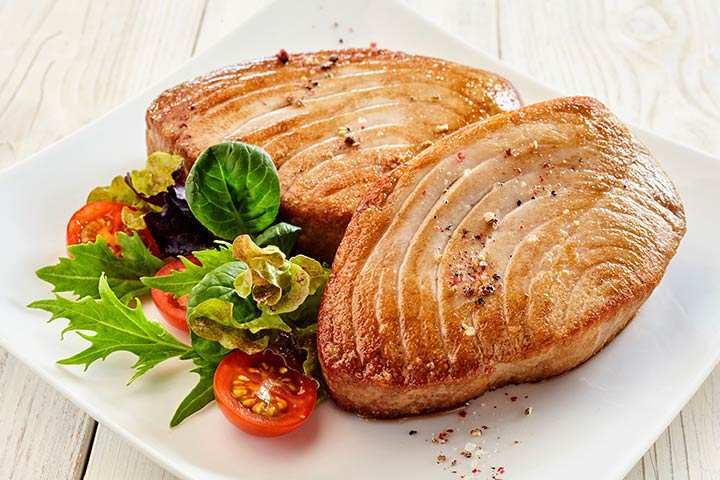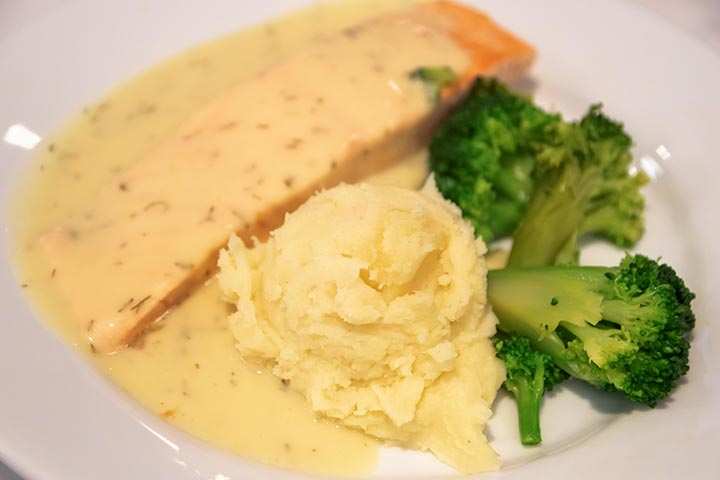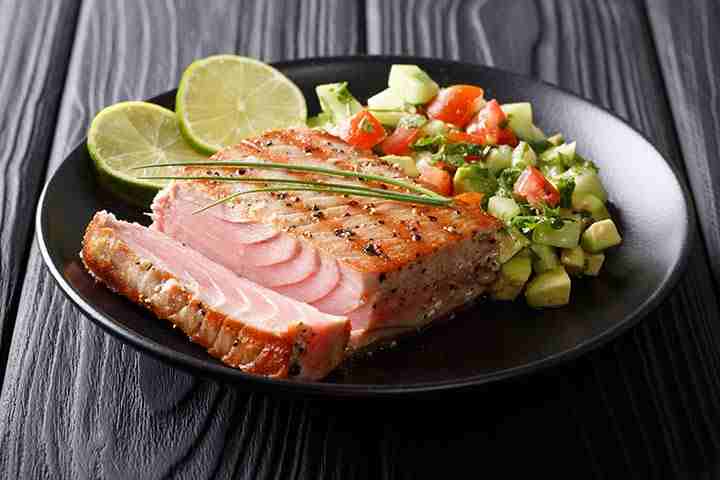Tuna is among the most eaten fish in the world. The United Nations even celebrates the second of May as the “World Tuna Day” to mark the economic and nutritional importance of tuna (1). But, did you know that certain fish, like tuna, are quite likely to contain mercury (2)? Mercury can be bad for health, which makes you wonder if it is safe for babies to consume tuna?
In this MomJunction post, we provide all the information about the health benefits of tuna for babies, precautions to observe, and recipes to prepare the fish for infants.
Types Of Tuna – What Is Safe And What Is Not?
There are a total of 15 species of tuna, out of which five commercially important tropical species are most commonly used as food. These species are yellowfin, bigeye, bluefin, skipjack, and albacore (3).
Internationally, tuna is used fresh, frozen, or canned. As per FDA, the best choices of tuna are light canned skipjack tuna, canned/fresh/frozen albacore, yellowfin, and white tuna.
The FDA recommends avoiding bigeye tuna (4). These recommendations are made on the basis of mercury levels and other contaminants that might be present in the fish.
Can Babies Eat Tuna?
Yes, babies can eat tuna. However, the right age to include it in your baby’s diet is not clear.
According to the American Academy of Pediatrics, a baby’s diet can include fish within a few months of starting solids (5). Therefore, once your baby shows the signs of readiness for solids, then you can consider introducing tuna. However, it is best to consult a pediatrician before you feed tuna to your baby.
How Much Tuna Can A Baby Eat?
The US FDA and EPA recommend the consumption of one ounce (28 grams) of fish per week for kids aged two years. This recommendation mainly includes marine-derived “oily fish”, such as tuna (4) (6). However, for babies below two years of age, no specific serving size per day or week has been mentioned. To decide on a safe intake limit, consultation with a pediatric nutritionist is advisable.
Nutritional Value Of Tuna
Apart from being a good source of essential nutrients like omega-3 fatty acid, selenium, and vitamin-D, tuna has plenty of protein, too (7) (8).
Below is the approximate nutritional composition of 100 grams of fresh tuna.
| Name | Amount | RDA |
|---|---|---|
| Water | 74.03g | – |
| Energy | 109Kcal | – |
| Protein | 24.4g | |
| Total lipid (fat) | 0.49g | |
| Calcium, Ca | 4mg | 210mg (0-6 months) 270mg (7-12 months) |
| Magnesium, Mg | 35mg | 30mg (0-6 months) 75mg (7-12 months) |
| Phosphorus, P | 278mg | 100mg (0-6 months) 275mg (7-12 months) |
| Potassium, K | 441mg | 500mg (0-6 months) 700mg (7-12 months) |
| Sodium, Na | 45mg | 120mg (0-6 months) 200mg (7-12 months) |
| Selenium, Se | 90.6µg | 12µg |
| Niacin | 18.475mg | 5.4mg |
| Folate, total | 2µg | 24µg (0-6 months) 32µg (7-12 months) |
| Choline, total | 65µg | – |
| Vitamin B-12 | 2.08µg | 0.1µg |
| Vitamin D (D2 + D3) | 1.7µg | 10µg |
Sources: U.S. Department of Agriculture (9) and World Health Organization (10)
Health Benefits Of Tuna For Babies
Below are some benefits that your baby could reap by consuming tuna in a well-balanced diet.
- Growth and development: Coldwater fishes such as tuna are an excellent source of omega-3 fatty acids, such as DHA and EPA (11). Both EPA and DHA are essential fats that are required in optimum amounts to support the proper growth and development of your baby’s eye, brain, immune, and nervous system (12).
- Physiological functions: Protein helps in the regulation of various body functions crucial for sustenance (13). Tuna has a considerable amount of high-quality protein, which can be helpful in the healthy growth of the baby (14).
- Bone development: Vitamin-D is a fat-soluble vitamin that is necessary for calcium absorption. Besides, it is required to perform various other functions such as regulation of neuromuscular processes and hormone production in the body (15). Tuna is considered as an essential source of vitamin-D, considering the nutrient is naturally found in very few foods (16).
- Overall health: Tuna is a good source of various micronutrients such as magnesium, phosphorus, potassium, sodium, selenium, and thiamine. Owing to these nutrients, regular consumption of tuna could have beneficial effects on the overall health of the baby in the long run.
As you know the benefits, it is also wise to know the possible side-effects of consuming tuna.
Risks Of Tuna For Babies
Tuna (fresh/canned) is associated with mercury exposure. As per WHO consideration, mercury is one of the top ten chemicals of major public health concern (17). Exposure to mercury during the early years of life can cause serious health effects on the nervous, immune, and digestive systems.
Besides mercury, canned tuna has other possible contaminants due to commercial handling and processing. A few examples are the elements lead and cadmium, which can be bad for health too. Therefore, the Office of Community and Public Health, USA (OCPH) recommends “avoiding excessive amounts of tuna in diet”. Eating one can per week should not be a problem for children under six years of age (18). However, it is best to stick to an ounce or less for babies. Consult a pediatrician or pediatric dietician to learn the safe quantity of tuna for your baby.
Precautions To Take While Introducing Tuna To Babies
Below is a list of precautionary steps to observe when feeding tuna to babies.
- Acknowledge the fact that all tunas can be possibly contaminated. It may not always be possible to avoid mercury entirely. So look for options with less mercury over the ones with possibly higher levels. Canned tuna, especially white, tend to have high amounts of mercury, whereas canned light tuna is considered to have low levels of mercury.
- Follow FDA’s latest advice about eating fish. It will help you choose the best for your baby and yourself.
- Check for labels while you are buying canned tuna. Labels will help you identify the safest option available over the shelf.
- As you prepare tuna for your baby, ensure that you remove bones. This is important if you are using fresh tuna instead of canned.
- While feeding, start with small amounts. Watch for the possible signs of fish allergy or intolerance. If any concerns are observed, discontinue feeding immediately.
- Avoid introducing tuna with any other new food. It can help you determine allergies easily and might also prevent any cross-reaction with other food items.
- To know more about the levels of mercury, see the FDA food safety website or the EPA website. You can also look for your local advisories, especially for tuna caught fresh.
Precautionary steps, when followed accurately, mitigate the potential health risks associated with tuna.
Let’s check some interesting recipes that you could try for your baby.
Tuna Recipes For Babies
Tuna puree is the simplest option to choose when introducing tuna to the baby for the first time. Once your baby gets comfortable with it, then you can try these interesting and nutritionally sumptuous recipes.
1. Tuna Mash Pie
An ideal tuna recipe since it is easy to swallow and is nutritionally balanced.
You will need:
- 1 small potato (peeled and diced)
- 1 cup broccoli
- 20g tuna (canned, light)
How to:
- Take a thick bottom pan and boil potato in water for 15 minutes.
- Mash the boiled potato with a fork until you get a rough paste.
- Next, wash and separate the broccoli florets. Put the cleaned florets and tuna in another pan and boil them for about 10 minutes.
- Drain the water and add the mashed potato to the cooked broccoli and tuna.
- Stir together until all mixed. Serve the dish warm
2. Grilled tuna with avocado and cucumber
You will need:
- ¼ cucumber, diced
- 1 cup small tomatoes or cherry tomatoes, sliced
- ½ tbsp finely chopped fresh ginger
- 3 medium onions, chopped
- 1 tbsp lime juice
- ¼ tsp salt
- 1 avocado, thick slices
- 2 fresh wild tuna steaks (approx. eight ounces or 226 grams)
- 1 tbsp sesame seeds, roasted
- Extra virgin olive oil
How to:
- Take a medium-sized bowl, put the cucumber, tomatoes, ginger, onions, lime juice, one tablespoon olive oil, and salt.
- Mix everything together well and then fold the mixture in the avocado slices.
- Meanwhile, heat the grill to medium-high.
- As the grill is getting heated, rub both sides of the tuna with oil.
- Grill each side for three to four minutes.
- Once done, slice the tuna and sprinkle sesame seeds.
- Serve hot with a homemade sauce of your choice.
Tuna is a good choice provided you select its variety wisely. It is a food item that could possibly fill your baby’s diet with essential nutrients like DHA and high-quality protein, which are vital for the proper growth and development.
How have you introduced tuna in your baby’s diet? Share your experiences with us in the comments section below.











